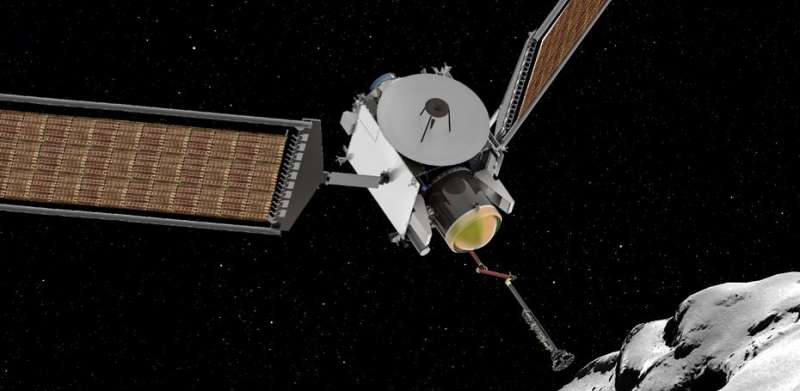Proposed CAESAR mission to return a sample from comet 67P/Churyumov–Gerasimenko

A proposed space mission known as the Comet Astrobiology Exploration Sample Return (CAESAR) could expand the knowledge of the origin and history of the comet 67P/Churyumov–Gerasimenko. If selected by NASA, it will return a sample from this comet to Earth, enabling scientists to study the leftover material from the formation of our Solar System.
CAESAR is one of the two finalists for NASA's next mission under the New Frontiers program. The project will receive funding through the end of 2018 to further develop and mature the mission concept. The decision whether or not CAESAR is selected for the development and launch will be made by the agency in the spring of 2019.
"We are just beginning Phase A of the mission. The focus of Phase A is developing and defining the project requirements and cost/schedule basis, and designing a plan for implementation," said CAESAR Principal Investigator Steve Squyres of Cornell University in Ithaca, New York.
The CAESAR probe will be based on Orbital ATK's GEOStar-3 electric propulsion spacecraft, with a configuration that emulates the arrangement used for NASA's Dawn mission. Power for the spacecraft will be provided by large Roll-Out Solar Arrays built by Deployable Space Systems.
The science payload of CAESAR will be dedicated to sample acquisition and preservation, and consists primarily of a Sample Acquisition System (SAS), a Sample Containment System (SCS), and a Gas Containment System (GCS). The final element of the science payload is a Camera Suite designed for selecting the sample site and documenting the sampling process.
At the comet, SAS should acquire the sample and SCS should store the solid sample. The GCS is designed to store volatile materials that evolve from the solid sample. After completing its science mission at 67P/Churyumov–Gerasimenko, the SCS and the GCS components will return to Earth aboard the spacecraft.
"CAESAR is a sample return mission. All aspects of the mission have been designed to maximize the scientific value of the returned sample. So the main CAESAR science will take place in laboratories on Earth, using state-of-the-art instrumentation to analyze both non-volatile and volatile material from comet 67P," Squyres said.
CAESAR will be the second mission to 67P/Churyumov–Gerasimenko. The first spacecraft sent to this comet was ESA's Rosetta, which arrived there in August 2014. The mission's Philae lander performed the first successful landing on a comet in November 2014.
In general, Rosetta delivered crucial information improving our understanding of comets. The results provided by the spacecraft suggest that comets are ancient leftovers of early solar system formation, rather than fragments of collisions between larger bodies later on.
Now, scientists believe that the CAESAR mission seen as Rosetta's successor will be even more fruitful when it comes to acquiring essential scientific data.
"Rosetta laid the groundwork for CAESAR by providing detailed remote sensing and in situ investigation of the nucleus of 67P. The information gathered by Rosetta is part of what makes CAESAR possible. CAESAR will make a quantum leap beyond Rosetta by acquiring a sample from the nucleus of 67P and bringing it back for analysis in laboratories on Earth," Squyres noted.
However, Squyres said that NASA's Stardust is more scientifically comparable to CAESAR. It returned a sample from the coma of the comet 81P/Wild. The material was collected by flying through 81P's coma in January 2004 at more than 13,400 mph. The total sample mass collected by the spacecraft was about 1 milligram, and the samples were significantly modified by heating during the high-speed collection process.
"In contrast, CAESAR will collect about 100 grams of sample, 100,000 times more than Stardust. The CAESAR sample will be collected at ambient comet temperatures, and protected from alteration all the way through the Earth return process. The Stardust mission was a substantial achievement, and provided significant discoveries regarding the nature and origin of comets. CAESAR will be a quantum leap beyond Stardust," Squyres said.
Source: Astrowatch.net





















